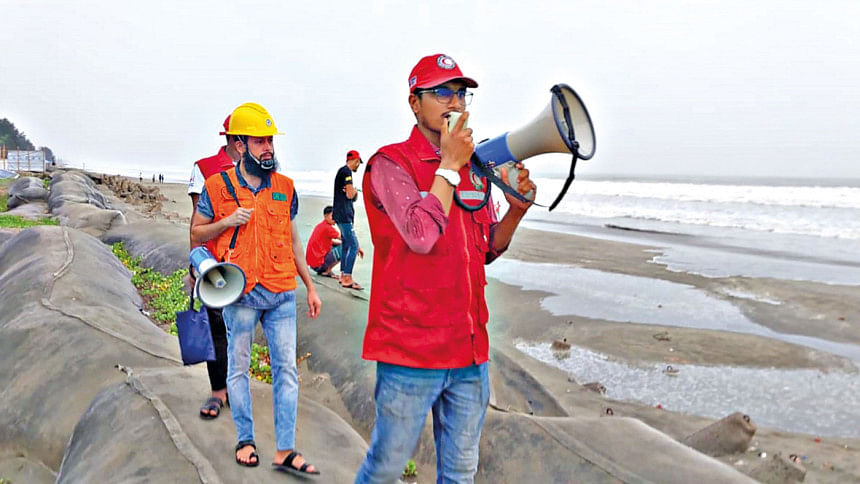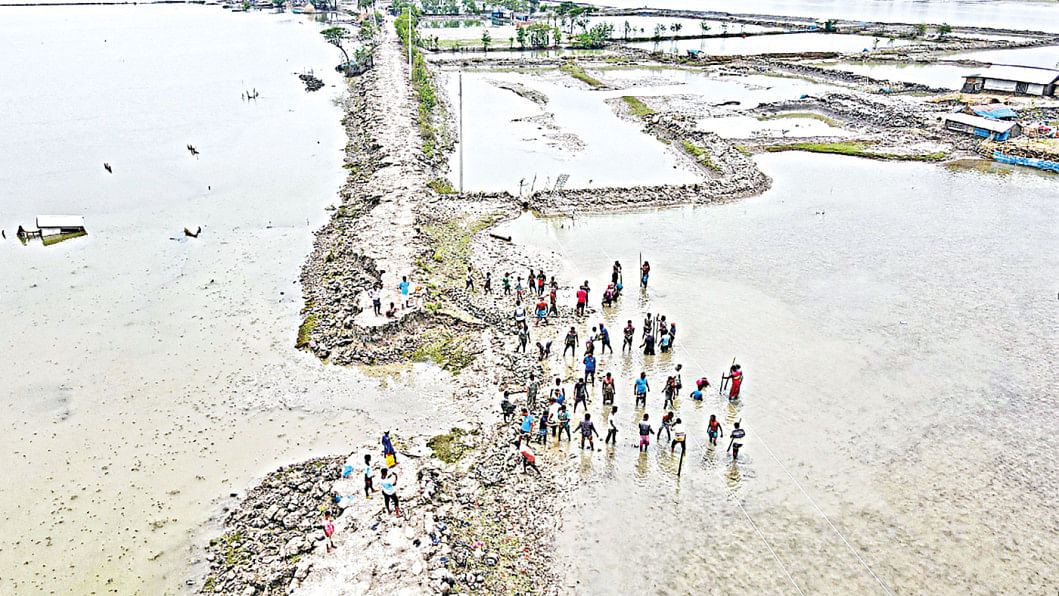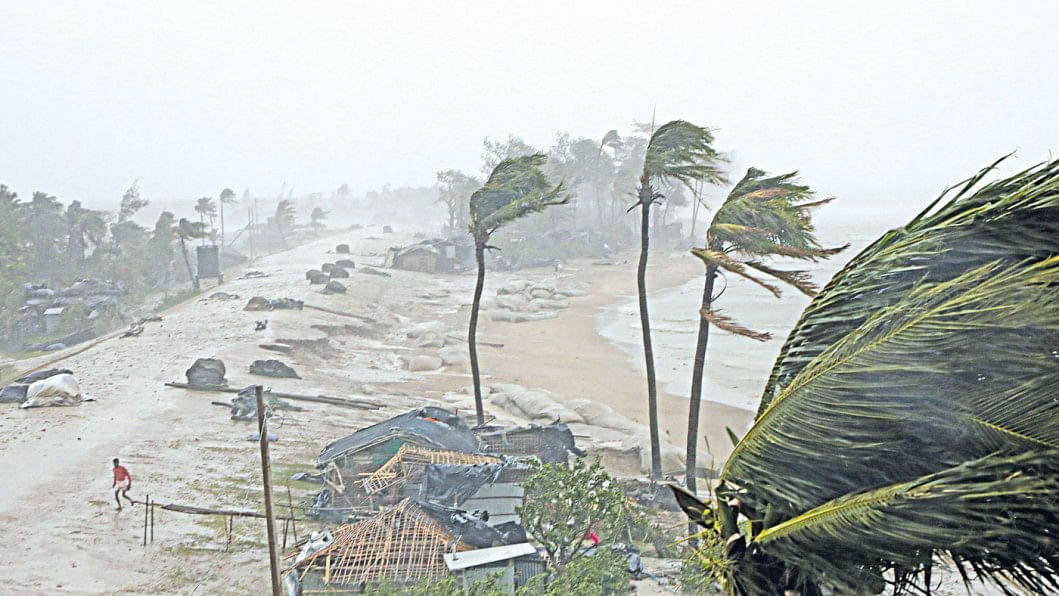Over the past 54 years, Bangladesh has made remarkable strides in disaster management, transforming itself from one of the world's most vulnerable countries into a global example of resilience and preparedness. A wide range of measures has been introduced at various levels to minimise damage and save lives—from the construction of cyclone shelters and embankments to the deployment of early warning systems and community volunteers. Technological advancements are enhancing these efforts, while innovative strategies from around the world continue to shape the modernisation of disaster management in Bangladesh.
A key government priority today is to reduce the economic toll of disasters by strengthening disaster risk reduction in line with Bangladesh's Seventh Five-Year Plan and the Sustainable Development Goals. Achieving this vision requires more than infrastructure and technology—it demands a people-centred approach that responds to the needs, experiences, and aspirations of those most at risk.
As risks evolve, so too must our approach. Disaster management must place people at its core. Making systems more accessible, inclusive, and people-friendly is crucial to ensuring that no one is left behind when disaster strikes.

Embankments
To stop the sea's fury during a cyclone, we have to build embankments along riverbanks and coastal lines. Unfortunately, our embankments often cannot withstand the normal tides of September (Bhadra). In the recent past, we witnessed the collapse of embankments in Shoronkhola (Bagerhat) when the cyclone was far away in Odisha (India). But there are other stories of long-lasting embankments as well.
Bangladesh has two successful examples of constructing high-quality embankments by involving the people of the vulnerable areas from the very beginning, as well as including them in ongoing maintenance. One is in Bhola and the other in Lakshmipur. These embankments remain strong 35 years after their construction.
On 28 May 2024, while visiting Koyra (Khulna) to see the aftermath of Cyclone Remal, I found a group of affected people with baskets and shovels repairing the embankments as the river water began to recede. They were working without any wages, with elderly people, women, and children all helping. There, I had the opportunity to meet and talk with Nilmoni Mondal, a day labourer who cannot support his family if he misses even a single day of work. Yet he volunteered to join the embankment repair work along the Shakbaria River without any payment.
I asked him, "Why are you giving 'baagar' (the local term for unpaid work) when you have no means to run your family?"
"We have no other option. If we don't work on 'baagar', it will take too long to fix this embankment. By then, there will be no way to live in this locality," he replied.
He continued: "Our disaster should be a matter of our management. We can't wait for your solution. We can't wait for the elephant (he was referring to the government) to come and fix the embankment. The elephant is great and heavy—perhaps even long-lasting—but it moves slowly. Perhaps you know the saying: 'Shomoyer ek fuor, ashomoyer dosh fuor' (One timely blow is worth ten untimely blows)."

The Story of Palm Trees and Lightning
Each year, more people are killed by lightning than by floods or cyclones. In 2025, up to 16 June, at least 171 people have been killed by lightning—seventy-five of them were farmers working in the fields. In 2011, a single lightning strike killed 13 people in Saraswatipur village of Sunamganj. A few years ago, in the month of August, 17 people were killed during a wedding party in Chapainawabganj.
Curtin University in Australia has conducted research on lightning incidents in Bangladesh. According to their findings, Bangladesh experiences an average of 8.4 million lightning strikes each year, 70 percent of which occur between April and June. Their accumulated data confirmed that around 1,878 people died from lightning strikes in Bangladesh between 2013 and 2020, 72 percent of whom were farmers.
The country's policymakers declared lightning a disaster in 2016 and promised to take necessary steps to address it. At that time, it was decided to plant 10 million palm trees and install lightning arresters on electric poles. However, after four years, it was discovered that the "Qazi's cows were in the book but not in the cowshed" (an expression meaning the promises existed only on paper).
The Ministry of Disaster Management claims that 3.5 million palm trees have been planted. Even if this claim is accurate, they are not in a position to prevent lightning strikes. It takes ten years for a palm tree to grow. Furthermore, palm trees were not planted where they were actually needed. They were mostly planted along roadsides, but very few people die from lightning while on the road. People die in the fields. Farmers are particularly vulnerable to lightning strikes while farming. It seems that mistakes were also made in selecting the locations for planting palm trees. We need to verify the truth of these allegations and revise our plans if necessary.
If the alternative to palm trees is lightning protection towers, then we need to think about that. We need to act before another lightning season arrives. If Vietnam and Nepal can do it, why can't we? Before citing financial crisis as an excuse for not installing lightning protection devices, we must consider the value of human lives. People should be encouraged to plant palm trees, date palms, and other suitable species in appropriate places, and the cutting of palm trees must be stopped. The selling and buying of boats made from palm trees (dunga) in open markets and the plantation of palm trees cannot go hand in hand.
Tularampur Haat, on the Narail-Jashore road, is one such major dunga haat where palm (taal) trees are sold in the form of boats. Every Friday and Monday from June to September, this market operates, and at least five to six thousand dungas are sold each season.
This year, a group of young people wrote a letter to the Deputy Commissioner of Narail, urging action to stop the haat and save thousands of mature taal trees. These young people are still waiting for a reply and positive action.
Coastal Green Belts and Shipbreaking Yards
Through afforestation and tree-planting programmes along the coast, it is possible to prevent erosion and reduce damage from other natural disasters in coastal areas. The Green Belt Project, funded by the Asian Development Bank (ADB) in 1995, aimed to achieve this. However, much of the project, which ended in 2002, is now in disrepair. Over the past 25 years, more than 50 percent of the once-beautiful keora-bain-jhauban, paraban, and mangrove forests in the country's coastal areas have been destroyed.
Large sections of forest land have been cleared to build shipbreaking factories. As a result, the coastal map is changing due to increased sea erosion and storm surges. Croplands are being destroyed by rising salinity levels. A terrible environmental disaster is unfolding, putting the 715-kilometre-long coastal belt at serious risk.
This information was highlighted in a report by National Geographic a few years ago. Various international environmental organisations, including Greenpeace, have consistently expressed concern over the waste disposal practices of Bangladesh's shipbreaking industry. All harmful chemicals, including heavy metals and oil, are directly discharged as waste from this industry, severely damaging marine biodiversity. It is not only the shipbreakers—shrimp cultivators and salt field owners are also destroying the mangrove forests.
What Trees Are Being Planted?
There is no alternative to social forestry or the creation and maintenance of forests in coastal areas. People are planting trees and making efforts to protect them, which is very encouraging. However, the types of trees being planted also matter.
After Cyclone Sidr, it was observed that while many people were swept away by the cyclone and tidal waves, almost twice as many people died from falling trees. The trees that were uprooted were not native varieties. When planting trees in cyclone-prone areas, safety considerations should come before commercial interests. The uprooted trees were not native species. When planting trees in these vulnerable zones, safety must take precedence over commercial value.
Why Are People Reluctant to Use the Cyclone Shelters?
Many changes have been made to the design of cyclone shelters to meet the special needs of people of all ages in coastal areas. In the past few years, around 320 new cyclone shelters have been built, with space to accommodate livestock as well. These centres can shelter approximately 256,000 people and about 44,000 livestock in times of immediate danger.
Despite these improvements, why do people still hesitate to go to the shelters voluntarily? Why is there no spontaneity?
Why would people go to a shelter where only two square feet of space is allotted to each person? With technological advancements, in the past it was possible to receive accurate cyclone forecasts 24 to 36 hours in advance. Now such information is available even earlier. To ensure safety, the concerned administration also issues 'evacuation orders' to move to shelters nearly 50 or more hours before the cyclone is expected to hit.
But is it realistic to expect people to wait in such cramped spaces for so long? Do we have no other options besides these so-called shelters?
A group of teachers, engineers, and architects from BUET calculated that it is possible to build around 32 to 33 storm-resistant houses for the cost of constructing one cyclone shelter. Almost twice as many people as one shelter can accommodate could take refuge comfortably in these houses.
If such houses exist in neighbourhoods, there would be no need to run around with belongings 50 hours before a cyclone hits. This is not merely a theoretical calculation—such a house has already been built in Kalapara, Patuakhali. Now, similar houses are being constructed in other areas through private initiatives using different designs.

Cyclone Warning
We still receive cyclone warnings designed primarily for ports and ships. A complex maze of signals—such as 'distant warning signals', 'distant cautionary warning signals', 'local warning signals', 'local cautionary signals', 'distress signals', 'great distress signals', and 'signals for communication loss'—creates confusion.
The general public living in vulnerable areas still do not understand the meanings of these various signals.
People living in places like Dhalghata or Chhnua do not understand how the signal suddenly jumps from number 5 to number 8 without passing through 6 and 7. Yet before every cyclone, these signals are broadcast over cable, radio, loudspeakers, and mobile phones.
If you call 1090 at no cost, you will receive advance warning of a thunderstorm. But, like the earlier radio broadcasts, you will hear the phrase: "There may be occasional rain in one or two places, somewhere, sometime, either in the day or at night." It sounds like a nonsensical rhyme.
Last December, when the Indian districts adjacent to Bangladesh were bracing for the arrival of Cyclone Jawad, while the panchayats were broadcasting messages over microphones about the rain and advising farmers on what to do, we in Bangladesh were still hearing the same old message—the broken record of warning signal number 3—broadcast from Satkhira to St. Martin.
The Cyclone Preparedness Programme (CPP) is now much more extensive than before. However, there are many questions about its quality and continuity. This programme once played a significant role in developing rural leadership. In the past, the mock drills were far more innovative, regular, well-planned, and engaging. Nowadays, however, they fail to attract audiences or generate interest. In most cases, the average age of CPP volunteers is over 50, which means it fails to attract the new generation and youth.
Floods and River Erosion
Floods and river erosion are part of life in Bangladesh, a country of river basins. Bangladesh has developed because it has the ability to live with floods. We need to think more about controlled flooding rather than focusing solely on flood prevention or full protection from floods.
Is it right to build flood shelters in the form of two-storey buildings in flood-prone and river erosion areas in the name of disaster risk reduction? Or would it be more prudent to raise the roofs and courtyards of people's homes?
These days, however, we hear more about mega-plans than basin- and town-based local plans. The 'Teesta Master Plan' to manage floods in the Teesta basin is one such mega project.
The main idea of the project is to reduce the current width of the river from the Bangladesh-India border downstream to the confluence of the Teesta and Jamuna rivers to between 700 and 1,000 metres. The depth of the river will also be increased to 10 metres.
According to the proposed master plan, the Teesta River will be brought under proper management through river governance.
Those who have studied rivers, even briefly, and are familiar with rivers like the Teesta, have unanimously called it an anti-nature project. Prominent river expert and geologist Mohammad Khalequzzaman (Professor, Lock Haven University, Pennsylvania, USA) has clearly stated that the water seen at the bottom as a result of deepening the river is actually nothing but groundwater located in the basin areas on both banks. Using this visible water for irrigation will lower the groundwater level in the basin, reducing the availability of drinking water and irrigation water extracted through shallow tube wells.
Furthermore, due to the construction of embankments on both banks of the river, the cross-section will be greatly reduced, resulting in a significant increase in water flow and current levels during the rainy season. This will dramatically increase the erosion susceptibility of both banks.
Let us start open discussions among experts on all river-related mega projects.
Bangladesh has already proven its ability to predict river erosion. The Centre for Environmental and Geographic Information Services (CEGIS), a government trust organisation, is doing this efficiently and with confidence.
It is important to find a sustainable way to communicate river movement information to people living in erosion-prone areas, utilising the capabilities of this government trust organisation.
We must also keep an eye on development-induced disasters, especially urban disasters. The work of a nationwide land use plan should begin this year. Otherwise, neither the cities nor the villages will be safe.
As Nilmoni of Koyra hints, we need our own disaster management strategy, with one hundred percent ownership by the people living in disaster-prone areas.
Gawher Nayeem Wahra is a researcher and author of the book Durjog Babosthaponay Bangladesher Orjon. He can be contacted at [email protected].


Comments